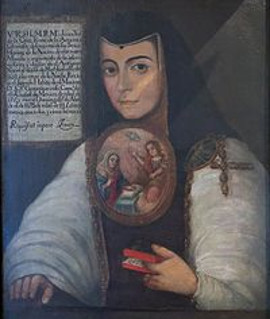

The vast array of skills and knowledge she demonstrated before the panel became publicly known throughout Mexico. When she was seventeen, the viceroy assembled a panel of scholars to test her intelligence. She continued to study privately, and, at sixteen, was presented to the court of the Viceroy Marquis de Mancera, where she was admitted to the service of the viceroy’s wife.

She longed to disguise herself as a male so that she could go to university but was not given permission by her family to do so. She also learned Nahuatl, an Aztec language spoken in Central Mexico, and wrote some short poems in that language.Īt age eight, after her grandfather’s death, Juana was sent to live in Mexico City with her maternal aunt. By adolescence, she had comprehensively studied Greek logic, and was teaching Latin to young children at age thirteen. She composed her first poem when she was eight years old.

Juana was a voracious reader in her early childhood, hiding in the hacienda chapel to read her grandfather’s books from the adjoining library. Her maternal grandfather owned property in Amecameca and Juana spent her early years living with her mother on his estate, Panoaya. To Paz her writings, like her life, epitomize the struggle of the individual, and in particular the individual woman, for creative fulfillment and self-expression.Born on Novem(though there is some dispute about the year), in San Miguel Neplantla, Mexico, Juana Inés de Asbaje y Ramírez was the illegitimate daughter of a Spanish father and Creole mother.

With critical authority he singles out the qualities that distinguish her work and mark her uniqueness as a poet. Just as Paz illuminates Sor Juana’s life by placing it in its historical setting, so he situates her work in relation to the traditions that nurtured it. Paz gives a masterly portrayal of the life and culture of New Spain and the political and ideological forces at work in that autocratic, theocratic, male-dominated society, in which the subjugation of women was absolute. Why did she become a nun? How could she renounce her lifelong passion for writing and learning? Such questions can be answered only in the context of the world in which she lived. Octavio Paz has long been intrigued by the enigmas of Sor Juana’s personality and career. Suddenly she surrenders her books, forswears all literary pursuits, and signs in blood a renunciation of secular learning. Her plays are performed, volumes of her poetry are published abroad, and her genius begins to be recognized throughout the Hispanic world. To the consternation of the prelates of the Church, she persists in circulating her poems, redolent more of the court than the cloister. Yet, no recluse, she transforms the convent locutory into a literary and intellectual salon she amasses an impressive library and collects scientific instruments, reads insatiably, composes poems, and corresponds with literati in Spain. For five years she enjoys the pleasures of life at court-then abruptly, at twenty, enters a convent for life. She becomes known for her beauty, wit, and amazing erudition, and is taken into the court as the Vicereine’s protégée. A spirited and precocious girl, one of six illegitimate children, is sent to live with relatives in the capital city. His subject is Sor Juana Inés de la Cruz, the most striking figure in all of Spanish-American colonial literature and one of the great poets of her age. Mexico’s leading poet, essayist, and cultural critic writes of a Mexican poet of another time and another world, the world of seventeenth-century New Spain.


 0 kommentar(er)
0 kommentar(er)
